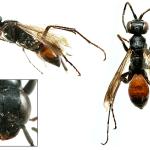Priocnemis hyalinata is one of two species of Priocnemis sens. str. which have an enlarged inner tooth on the tarsal claw. Females have the usual red and black pattern and are distinguished from the other species, fennica Haupt, by having shorter, thicker antennae. Males are black, often with some red on the second tergite, and usually with some red on the legs. They are most reliably determined by the internal genitalia which should be fully extracted.
Priocnemis fennica was only relatively recently recognised as British (Day, 1979) and older records, usually under the name Priocnemis femoralis, may apply to either species.
Restricted to southern Britain, predominantly in south-east England with a few scattered records further north and in south Wales.
Overseas it occurs in Europe, except in the south, and in central Asia east to Mongolia (Wolf, 1972). Fauna Europaea (Wahis, 2011) gives most of Europe, including Fennoscandia, but excluding Spain and Portugal. The inclusion of Ireland is at odds with Day (1988) and O’Connor et al. (2009) who consider that it is Priocnemis fennica that occurs there.
This species is listed as Nationally Notable/Nb (now known as Nationally Scarce) by Falk (1991).
Fairly open habitats, such as heathland, acid grassland and chalk downs, probably also in open areas in woods.
A summer species, flying from late June into September, with a peak in July-August.
Day (1988) cites a prey record of a lycosid.
No information available. Related species are fossorial, utilising natural cavities and old aculeate burrows where available.
Baldock (2010) records it at wild carrot (used as a lure) and bramble.
2016


